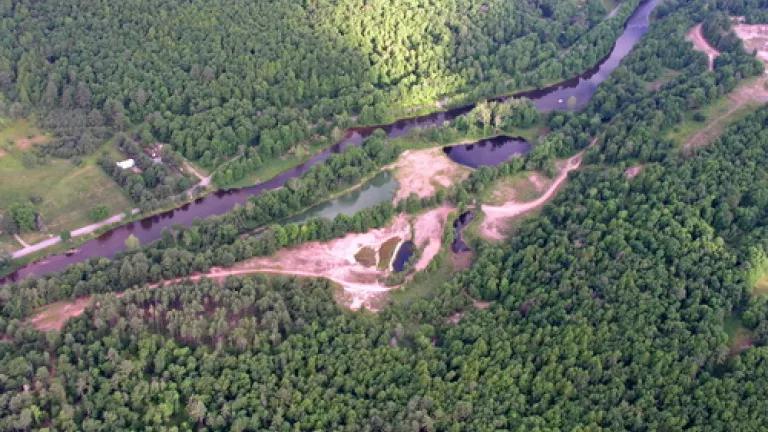
Environmental pop quiz.
This photo shows a segment of:
a. The famed Neversink River, the birthplace of American fly fishing;
b. One of the most important freshwater ecosystems in North America;
c. The habitat of the bald eagle, osprey, and 30 globally rare wildlife species;
d. The proposed site of Gov. Paterson's Las Vegas-style casino in the Catskills;
e. All of the above
The answer is (e).
In a surprise announcement yesterday, Governor Paterson said he is poised to make a deal with the Stockbridge-Munsee Tribe of Wisconsin that would allow them to build a gargantuan casino complex directly along a one-mile stretch of the Neversink River, in exchange for dropping some pending legal claims involving disputed land in upstate Madison County.
The proposed 333-acre site is located roughly 90 miles northwest of New York City in the Catskill Mountains, which encompasses the 700,000 acre Catskill Park and reservoirs that supply half the state’s drinking water every day (that’s 9 million New Yorkers, including all of NYC). Building this casino would undoubtedly bring significant negative environmental impacts to area, including a dramatic spike in traffic, increased air pollution, runoff into the Neversink River and new threats to our clean drinking water.
From reading initial news reports, one would think it’s too late and the dice would be rolling at this new Catskill casino by New Year’s Day. But fortunately Governor Paterson cannot legally pull a fast one on us that easily. By proposing to build this mega-casino on a pristine, historic river, the Governor is virtually inviting litigation on environmental and land use grounds. And there at least three significant legal requirements the Tribe and its development partner, Trading Cove, would still have to meet if they hope to open this gambling casino in the Catskills.
First, any final proposal would need to undergo a new and thorough environmental review under federal law. Specifically, under the federal National Environmental Policy Act (NEPA), the U.S. government must prepare an Environmental Impact Statement (EIS) for all “major Federal actions significantly affecting the quality” of the environment. In the tribe’s most recent proposal unveiled a few years ago, they sought to build a complex that would include a 580,000 square foot casino, a 750-room hotel, and 9,500 parking spaces at this same Neversink River site. The casino would have drawn roughly six million visitors a year, which is 40 percent more than the number of people who visit the Grand Canyon National Park every year.
Since undoubtedly the new proposal will be of similar size and scale, the first step will be to prepare an environmental review that, among other things, examines how the casino might directly impact water quality and the delicate ecosystem of the abutting Neversink River and the drinking water supply for so many New Yorkers. Indeed, the U.S Environmental Protection Agency has previously written that the proposed casino would have “unavoidable adverse impacts to the aquatic ecosystem” of the river. The project sponsors would also have to assess how this proposal – coupled with other possible Catskill casinos – could further clog Route 17 and other already-congested regional roads.
While some initial environmental reviews were launched in past years, a full environmental review has never been completed for this proposed Catskill casino (or any other proposed casino in the region). Further, in 2007, NRDC and the environmental community sued the government in federal court for its failure to fully comply with this bedrock environmental requirement in connection with the proposed building of another casino in the Catskills. And, given that Paterson’s proposed casino location is about as bad a location one could imagine from an environmental standpoint, it is likely that there will be future challenges to constructing a casino on the banks of this beloved River.
Second, the Governor’s plan requires the federal government to approve this proposed off-reservation Indian gambling casino. In short, the United States must decide to: (a) take the proposed 333-acre parcel on the Neversink River into “federal trust”; and (b) conclude that it is appropriate to allow full-scale gambling at this location. Less than three years ago, the U.S. Department of the Interior flatly rejected the Stockbridge Munsee’s proposal to take this Neversink site into federal trust for purposes of building a gambling casino on the grounds that it was located too far – 1,035 miles – from its Wisconsin reservation.
We take no position on the rationale of the Interior Department’s rejection, or on gambling more generally. And NRDC strongly supports the rights of Indian tribes to pursue economic self-determination. But we believe the environmental impacts this development would have at this site are far too great. And unless the Interior Department adopts new regulations or guidelines governing off-reservation Indian gambling (or Congress enacts a new law), Governor Paterson’s plan will unlikely be able to secure the necessary federal approvals anyway.
Lastly, although many of the details are unclear, it would appear that the part of the Paterson deal that would resolve the Stockbridge-Munsee land claims against New York State would require separate approval by Congress and the New York Legislature as well. Good luck getting that done quickly.
If I were a betting man, I would not be making any hotel reservations yet at Governor Paterson’s new casino palace. And that’s good news for those of us that value the clean rivers, drinking water and air -- and natural beauty -- of the Catskills.
